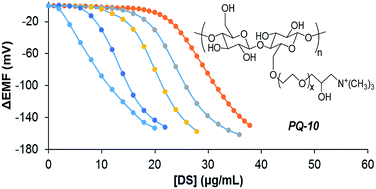Detecting levels of polyquaternium-10 (PQ-10) via potentiometric titration with dextran sulphate and monitoring the equivalence point with a polymeric membrane-based polyion sensor
Abstract
Polymeric quaternary ammonium salts (polyquaterniums) have found increasing use in industrial and cosmetic applications in recent years. More specifically, polyquaternium-10 (PQ-10) is routinely used in cosmetic applications as a conditioner in personal care product formulations. Herein, we demonstrate the use of potentiometric polyion-sensitive polymeric membrane-based electrodes to quantify PQ-10 levels. Mixtures containing both PQ-10 and sodium lauryl sulfate (SLS) are used as model samples to illustrate this new method. SLS is often present in cosmetic samples that contain PQ-10 (e.g., shampoos, etc.) and this surfactant species interferes with the polyion sensor detection chemistry. However, it is shown here that SLS can be readily separated from the PQ-10/SLS mixture by use of an anion-exchange resin and that the PQ-10 can then be titrated with dextran sulphate (DS). This titration is monitored by potentiometric polyanion sensors to provide equivalence points that are directly proportional to PQ-10 concentrations.

- This article is part of the themed collection: In memory of Craig Lunte

 Please wait while we load your content...
Please wait while we load your content...